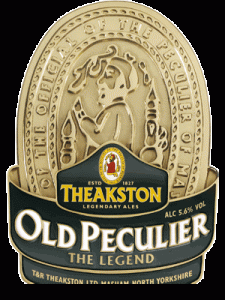Old Ale
 I must say to have a liking for “Old Ales”, when I was a young man in England I was partial to Theakston’s Old Peculier. It was, and still is, a warm, malty ale with a big heart and fruity finish. Not a session brew by any stretch, but something to warm the bones on a chill winter night.
I must say to have a liking for “Old Ales”, when I was a young man in England I was partial to Theakston’s Old Peculier. It was, and still is, a warm, malty ale with a big heart and fruity finish. Not a session brew by any stretch, but something to warm the bones on a chill winter night.
The Old Ale has a long history reflecting. not only the history of beer making in Britain, but a glimpse of the social history of the country also. Back in the 1800’s, before the time of the industrial revolution, stock ales, matured in oak casks, were served as a complement to mild ales, often with the landlord serving the customer a blend of the sharper stock ale with the fruitier, sweeter mild ale to the customer’s taste. The breweries caught on and began to produce their own stock ales, which became known as “Old Ales” due to the length of time they were conditioned in the cask. Old Ales were also considered the “top shelf” ale with the workers drinking the weaker common or mild ale during the week and then cracking the Old Ale on pay day.
To understand the process used to brew an historical Old Ale one has to understand a little of the All-Grain style of brewing, something I hope to get time for (and money for some neat equipment) later this year. For our recipes created to date we have substituted the base malt with some form of Malt Extract, e.g. DME. In the case of All-Grain brews the barley, typically Marris Otter or English 2-Row, are steeped in warm water for an hour or so to extract the sugars. Next the water, now called wort, is drained into the brew kettle (the first runnings) ready for the boil, a process known as “mashing“. Imagine brewing a cup of tea but instead of using a tea bag in a tea pot you have 100 lbs of grain in a steel mash tun. As the water is run off many of the sugars are left behind, attached to the grains, so more hot brew water (know as liquor) is used to rinse the grains and allowed to filter slowly into the kettle until enough wort has been collected to begin the boil, a process known as “sparging“. Think brewing a teabag for a 2nd time.
So back to the pre-industrial revolution brewery. To make Old Ale the brewery would take only the first runnings from the mash and brew a really strong, rich, high alcohol, brew (first teabag). Due to the high alcohol content the ale was left to condition for long periods of time in oak casks gaining almost sour, lactic acid flavour from the continuing fermentation in the cask. The breweries would then sparge the grains with enough liquor to create a second batch of weaker ale, known at the time as “Common Ale”, a process known as “parti-gyle” brewing (the second teabag). If the first runnings created a particularly strong brew a rinse was used to create a “Small Ale”. This process is still used by the Belgiums today to brew the Tripel, Dubbel, and Blonde (old, common, small).
Old Ales are still brewed today but using more moden, efficient methods. The strength and character vary widely with Old Ale filling the gap between brown ales, porters and barleywine including winter warmers, dark milds, and lower gravity barleywines. Some popular brews include Old Peculier, Fuller Vintage Ale, and J.W. Lees Moonraker.
I have brewed the New Old Ale recipe from Northern Brewer, voted my #1 brew of the year for 2009, and a VERY popular drink at my house and with friends. I plan to investigate a couple more Old Ales over the year, starting I hope with my favorite, Old Peculier 🙂
Pingback: British Brewer » Blog Archive » Recipe: Fullers London Pride (version 1.0)()
Pingback: British Brewer » Blog Archive » Brown Ale()